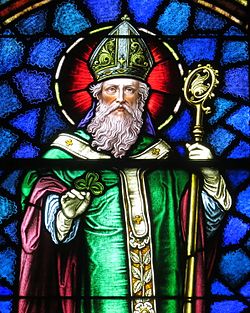Saint Patrick
| Christ died for our articles about Christianity |
| Schismatics |
| Devil's in the details |
In Roman Catholic mythology, Saint Patrick (Irish spelling Pádraig) is the patron saint of Ireland. He was actually born in Britain [1][2] (or possibly France)[3][4] when it was controlled by the Roman Empire, kidnapped by Irish raiders at the age of 12, and taken to Ireland as a slave. He escaped back to Britain, then returned to Ireland as a Christian missionary to convert the pagans. Because bringing Christianity to Ireland worked out enormously well.
His dates are unknown, although probably around the late 5th century CE; he was mentioned by Cummian in 622 or 623 but earlier sources are silent.[5] Patrick's writings include one of the small handful of contemporary sources for what was happening in Britain between the end of Roman government and the Anglo-Saxon takeover.
St. Patrick's Day is a joyous festival on March 17 and an excuse to wear green and drink lots of Guinness and Bailey's. (Basically, an excuse to get drunk.) In Ireland, it is colloquially referred to as "Paddy's Day" while most Americans prefer to say "Patty's Day", presumably because they cannot go for any length of time without thinking of burgers.
Legends
- He allegedly banished snakes from Ireland. If the legend is to be taken literally, it's weakened somewhat by the lack of snake fossils. Ice ages and the Irish Sea probably ensured lazy snakes never even got to Ireland.[6]
- He used the shamrock to explain the Christian doctrine of the trinity [7] This story has been dated to 1726, more than 1200 years after Patrick's death.[8]
- To compete with a druid in a test of whose god was real or more powerful, they wet and burned their respective holy books to see which would survive, and then set fire to buildings they were in after swapping robes. Allegedly, the druid burned to death inside Patrick's untouched cloak, whereas Patrick survived as the pagan cloak burned around him. To readers of the Bible, it should be obvious where the idea of testing each other's god was ripped from.
Two Patricks, more or less
T. F. O'Rahilly suggested the legends about Patrick originally referred to Palladius, who was sent to Ireland by Pope Celestine I in 431 CE. 7th-century hagiographer Tírechán portrays Patrick as a much tougher, more Chuck Norris-y figure, fighting druids and destroying pagan idols. Two writings by Patrick exist, which may be slightly more reliable about his life but contain none of the famous myths - Declaration (Confessio) and Letter to the soldiers of Coroticus. Hence the theory that there were 2 figures whose stories were confused to generate one St Patrick myth.[9]
See also
Want to read this in another language?
External links
References
- ↑ "Who was St. Patrick?" on History.com
- ↑ "St. Patrick" on Biography.com
- ↑ "St. Patrick was born and raised in France not Britain says new book", Irish Central, 5 August 2013
- ↑ Marcus Losack (2013); Rediscovering Saint Patrick: A New Theory of Origins, ISBN 1782180176
- ↑ See the Wikipedia article on Saint Patrick.
- ↑ Did St. Patrick Really Drive Snakes Out of Ireland?, James Owen, National Geographic, 2014
- ↑ Tom Stuart, "St. Patrick: The Trinity and the Shamrock", 22 July 2001
- ↑ Patrick uses shamrock in an illustrative parable on Wikipedia
- ↑ A Tale of Two Patricks, About.com
